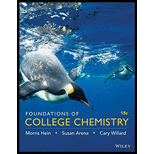
(a)
Interpretation:
The given compound
Concept Introduction:
An electronegativity of an atom gives information about the strength that the atom has for attracting a pair of shared electrons. The greater the attraction for a pair of shared electrons when the electronegativity value is high. Consequently, when two different electronegative atoms share a pair of electrons, one atom becomes partially positive and the other atom becomes partially negative due to the attractive forces for the pair of electrons.
If the difference in electronegativity is more than
(b)
Interpretation:
The given compound
Concept Introduction:
Refer part (a)
(c)
Interpretation:
The given compound
Concept Introduction:
Refer part (a)
(d)
Interpretation:
The given compound
Concept Introduction:
Refer part (a)
(e)
Interpretation:
The given compound
Concept Introduction:
Refer part (a)
(f)
Interpretation:
The given compound
Concept Introduction:
Refer part (a)
Want to see the full answer?
Check out a sample textbook solution
Chapter 11 Solutions
Foundations of College Chemistry 15e Binder Ready Version + WileyPLUS Registration Card
- Name each ionic compound. In each of these compounds,the metal forms only one type of ion. (a) CsCl (b) SrBr2 (c) K2O (d) LiFarrow_forward3. Using electronegativity difference, indicate the type of bond between the following atoms: (a) Li-Cl(b) C-Br(c) F-Cl(d) Br-Brarrow_forwardWrite the chemical formula for the ionic compound formed from each pair of ions.(a) Mg2+ and I-(b) Na+ and O2-arrow_forward
- Name each ionic compound. In each of these compounds, the metal forms more than one type of ion.(a)SnCl4(b)CuI2(c)Fe2O3(d)HgBr2arrow_forwardWrite a formula for each ionic compound.(a) copper(II) bromide(b) silver nitrate(c) potassium hydroxide(d) sodium sulfate(e) potassium hydrogen sulfate(f) sodium hydrogen carbonatearrow_forward- Classify each compound as ionic or molecular. If it is ionic, determine whether the metal forms only one type of ion or more than one type of ion. (a) CoCl2 (b) CF4 (c) BaSO4 (d) NOarrow_forward
- Draw a Lewis structure for each of the following molecules and ions. In each case, the atoms can be connected in only one way. (a) Br2 (b) H2S (c) N2H4 (d) N2H2 (e) CN- (f) NH4+ (g) N2 (h) O2arrow_forwardWrite the name of each of the following substances: (W (a) (HCOO)2Ni-½H2O (b) Zn(SCN)2 (c) Ag2CrO4 (d) HIO2(aq)arrow_forwardWrite a Lewis structure for each of the following molecules or ions. (a) H3BPH3(b) BF4−(c) BBr3(d) B(CH3)3(e) B(OH)3arrow_forward
- What are the following substances? Give one example of each type.(i) Antacid(ii) Non-ionic detergents(iii) Antisepticsarrow_forwardPredict which of these compounds are ionic and which are covalent. State your reasoning.(a) SF6(b) KBr(c) N2O3(d) BaS(e) CaCO3(f) C6H5Clarrow_forward11) What is the name of CoS?arrow_forward
 ChemistryChemistryISBN:9781305957404Author:Steven S. Zumdahl, Susan A. Zumdahl, Donald J. DeCostePublisher:Cengage Learning
ChemistryChemistryISBN:9781305957404Author:Steven S. Zumdahl, Susan A. Zumdahl, Donald J. DeCostePublisher:Cengage Learning ChemistryChemistryISBN:9781259911156Author:Raymond Chang Dr., Jason Overby ProfessorPublisher:McGraw-Hill Education
ChemistryChemistryISBN:9781259911156Author:Raymond Chang Dr., Jason Overby ProfessorPublisher:McGraw-Hill Education Principles of Instrumental AnalysisChemistryISBN:9781305577213Author:Douglas A. Skoog, F. James Holler, Stanley R. CrouchPublisher:Cengage Learning
Principles of Instrumental AnalysisChemistryISBN:9781305577213Author:Douglas A. Skoog, F. James Holler, Stanley R. CrouchPublisher:Cengage Learning Organic ChemistryChemistryISBN:9780078021558Author:Janice Gorzynski Smith Dr.Publisher:McGraw-Hill Education
Organic ChemistryChemistryISBN:9780078021558Author:Janice Gorzynski Smith Dr.Publisher:McGraw-Hill Education Chemistry: Principles and ReactionsChemistryISBN:9781305079373Author:William L. Masterton, Cecile N. HurleyPublisher:Cengage Learning
Chemistry: Principles and ReactionsChemistryISBN:9781305079373Author:William L. Masterton, Cecile N. HurleyPublisher:Cengage Learning Elementary Principles of Chemical Processes, Bind...ChemistryISBN:9781118431221Author:Richard M. Felder, Ronald W. Rousseau, Lisa G. BullardPublisher:WILEY
Elementary Principles of Chemical Processes, Bind...ChemistryISBN:9781118431221Author:Richard M. Felder, Ronald W. Rousseau, Lisa G. BullardPublisher:WILEY





